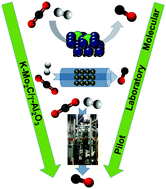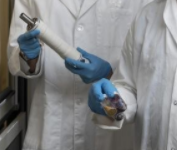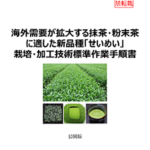(This low-cost catalyst helps turn seawater into fuel at scale)
2020/7/15 アメリカ合衆国・ロチェスター大学
・ ロチェスター大学、米国海軍調査研究所(NRL)、ピッツバーグ大学および OxEon Energy 社が共同で、カリウムを添加した炭化モリブデン触媒が効率的かつ安定的に CO2 を CO に転換することを実証。
・ NRL は、触媒コンバーターを利用して海水から抽出した CO2 と水素を 92%の効率性で炭化水素液体に転換することに 2014 年に成功している。それ以来、同プロセスの効率性の向上とスケールアップによる燃料生成量の増量を目指してきた。
・ 数種の原子力空母や潜水艦を除き、海軍艦船の多くはタンカーとの定期的な接舷により燃料を補給するが、悪天候下では困難となる。海水から燃料を生成できれば、継続的な運航が可能となる。
・ 海水から抽出した CO2 の炭化水素液体への直接転換は、既存の技術では極めて困難。そのため、まずは逆シフト反応(RWGS)で CO2 を CO に転換し、CO をフィッシャー・トロプシュ法で炭化水素燃料に転換する。
・ 通常、RWGS の触媒には高価な貴金属が含まれており、反応条件下で急速に不活性化する。一方、ガンマアルミナの表面に担持した炭化モリブデンにカリウムを添加した新触媒は低コストの成分で合成され、安定性と高選択性を提供する。パイロットスケールでの 10 日間の継続的な調査では、不活性化の兆候が観られなかった。
・ カリウムが RWGS の反応に伴うエネルギー障壁を低下させ、スポンジのような溝や孔を備えたガンマアルミナが炭化モリブデン触媒粒子の分散状態を維持することで、反応の起こる表面を最大化する。
・ 発電所から排出される CO2 の捕獲と転換での同触媒の有用性を調査するため、燃焼ガスに含まれる水銀、硫黄、カドミウムや塩素等に曝された場合の同触媒の安定性を確認する試験を実施する予定。
・ 本研究は、米国海軍研究局(ONR)のアワードが支援した。
URL: https://www.rochester.edu/newscenter/chemical-catalyst-helps-convert-seawater-intofuel-industrial-scale-444112/
<NEDO海外技術情報より>
(関連情報)
Energy & Environmental Science 掲載論文(アブストラクトのみ:全文は有料)
Assessing the viability of K-Mo2C for reverse water–gas shift scale-up: molecular to laboratory to
pilot scale
URL: https://pubs.rsc.org/en/content/articlelanding/2020/ee/d0ee01457e#!divAbstract
Abstract
Conversion of CO2 to value-added chemicals and fuels is a potentially valuable route for renewable energy storage and a future CO2-neutral economy. The first step is CO2 conversion to CO via the reverse water–gas shift (RWGS) reaction. Effluent CO can then be hydrogenated to chemicals and fuels via Fischer–Tropsch (FT) synthesis over a tandem catalyst or within a second reactor. To implement this process on an industrial scale, low-cost, scalable and highly-selective catalysts are required, prompting investigations into materials that meet these design constraints. Potassium-promoted molybdenum carbide supported on gamma alumina (K-Mo2C/γ-Al2O3) has recently been shown to be a highly active and selective RWGS catalyst in the laboratory, prompting us to investigate the viability of K-Mo2C/γ-Al2O3 for scale-up. In this report, laboratory-scale (∼100 mg catalyst) reactor studies are extended to the pilot-scale (∼1 kg catalyst), and viability for scale-up is tested further with density functional theory (DFT) calculations, detailed characterization and reactor experiments under a range of temperatures (300–600 °C) and flow conditions. The pilot-scale experiments illustrate K-Mo2C/γ-Al2O3 is a highly active and selective catalyst (44% CO2 conversion, 98%+ CO selectivity at GHSV = 1.7 L kg−1 s−1 and T = 450 °C) that exhibits no signs of deactivation for over 10 days on stream. Together, experiments across the molecular, laboratory and pilot scales demonstrate that K-Mo2C/γ-Al2O3 is an economically-viable RWGS catalyst with promising future applications in the US Naval Research Laboratory’s seawater-to-fuel process, downstream methanol synthesis and FT.




